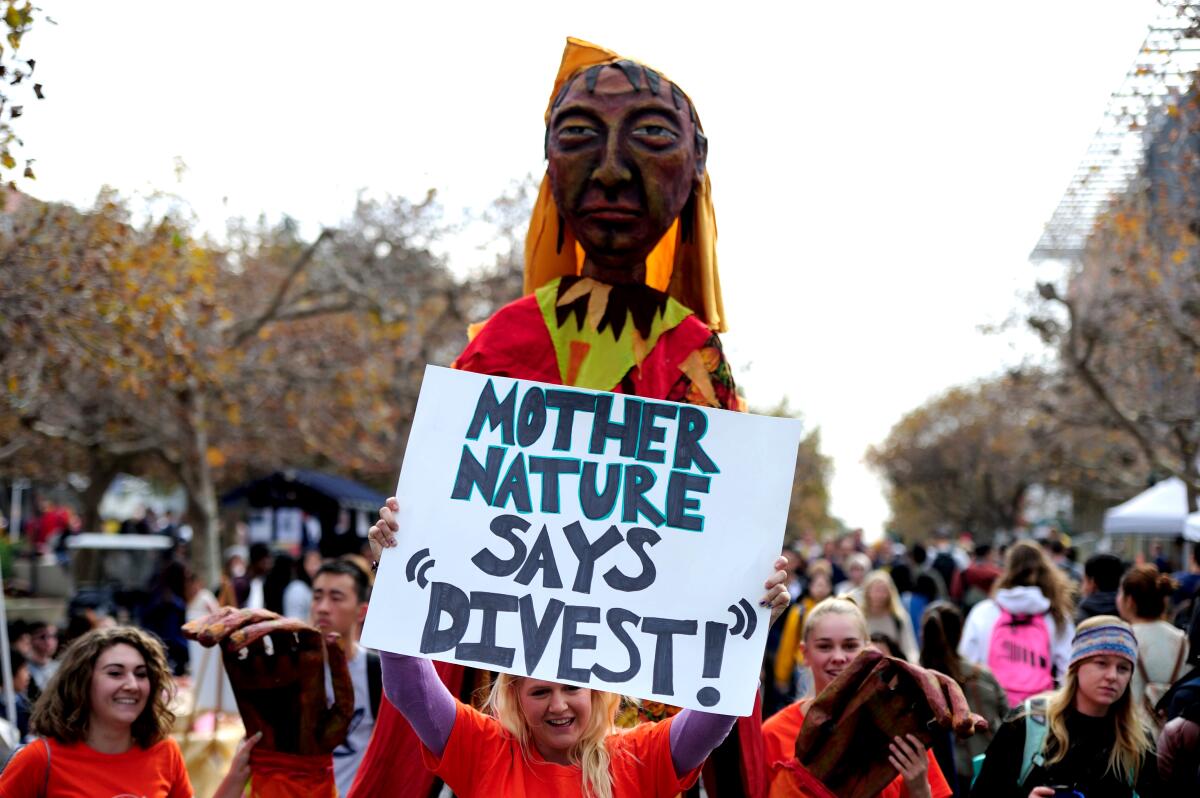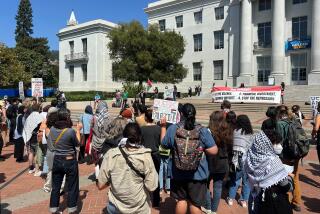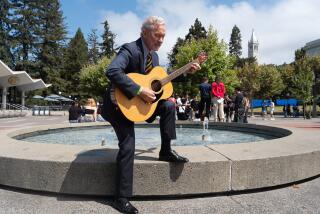Opinion: UC investments are going fossil free. But not exactly for the reasons you may think

- Share via
Our job is to make money for the University of California, and we’re betting we can do that without fossil fuels investments.
We are investors and fiduciaries for what is widely considered the best public research university in the world. That makes us fiscally conservative by nature and by policy — “Risk rules” is one of the 10 pillars of what we call the UC Investments Way. We want to ensure that the more than 320,000 people currently receiving a UC pension actually get paid, that we can continue to fund research and scholarships throughout the UC system, and that our campuses and medical centers earn the best possible return on their investments.
We believe hanging on to fossil fuel assets is a financial risk. That’s why we will have made our $13.4-billion endowment “fossil free” as of the end of this month, and why our $70-billion pension will soon be that way as well.
This risk-averse reasoning might not jibe with what you will read in a newspaper headline or scroll through in a news feed on your phone. Some might see our action as born of political pressure, or as green movement idealism or perhaps political correctness run amok. So be it; we are part of a university system where diversity of opinion thrives.
But none of these perspectives paints a full picture of what UC Investments has done or why it matters. The bigger, more significant story of how we manage UC’s money began five years ago and reflects a long view of investing for the benefit of the university.
In 2014, when both of us were brand new to our roles, UC Investments had no structural approach to sustainable investing. Today, we are on track to beat our own five-year goal of investing at least $1 billion in climatechange solutions and, by incorporating environmental, social and governance factors — ESG factors — into our investment decision-making, we’ve become better stewards of university funds.
That year we were the first public university in the United States to sign onto the U.N.’s Principles for Responsible Investing. In 2015, UC Investments published its own Framework for Sustainable Investing, which identifies the eight ESG factors most salient to our work. In 2018, the UC Board of Regents publicly changed the university’s investment policy to explicitly include ESG in investment decision-making. And this year, in response to these and other initiatives, the Responsible Asset Allocator Initiative at New America recognized UC Investments as one of the world’s 25 most responsible institutional investors.
So what’s the bottom line?
In April 2014, when Jagdeep arrived to become UC’s chief investment officer, UC Investments had a total of $91.6 billion in assets under management. As of June 30, the total portfolio stood at $126.1 billion. In five years, that includes $2.4 billion in value added above our benchmarksand a savings of $1 billion in reduced costs of management.
During that same time frame, we made no new investments in fossil fuels and four years ago, we sold our exposure to coal and oil sands. We found them too risky — and it’s worth noting that Jagdeep joined UC from one of Canada’ sovereign wealth funds in the heart of the oil sands region. We continue to believe there are more attractive investment opportunities in new energy sources than in old fossil fuels.
All of this is by way of saying that we don’t make investment decisions simply based on the preferences of one group or another of our stakeholders, which is not to say we don’t listen to them. We should and we do, such as when the UC Academic Senate presented a “memorial” to the UC Board of Regents in July calling on us to divest our endowment of fossil fuels. We were already going there, or as Richard said in a statement at the time, we were “on a glide path to zero.” The same applies to the pension as well.
While our rationale may not be the moral imperative that many activists embrace, our investment decision-making process leads us to the same result. We’re in the business of helping to ensure the financial viability of a great university whose stakeholders frequently come at an issue — even one as terrifyingly consequential as climate change — from different perspectives.
The reason we sold some $150 million in fossil fuel assets from our endowment was the reason we sell other assets: They posed a long-term risk to generating strong returns for UC’s diversified portfolios.
We have been looking years, decades and centuries ahead as we place our bets that clean energy will fuel the world’s future. That means we believe there is money to be made. We have chosen to invest for a better planet, and reap the financial rewards for UC, rather than simply divest for a headline.
Jagdeep Singh Bachher is the University of California’s chief investment officer and treasurer. Richard Sherman is chairman of the UC Board of Regents’ Investments Committee.
More to Read
A cure for the common opinion
Get thought-provoking perspectives with our weekly newsletter.
You may occasionally receive promotional content from the Los Angeles Times.










